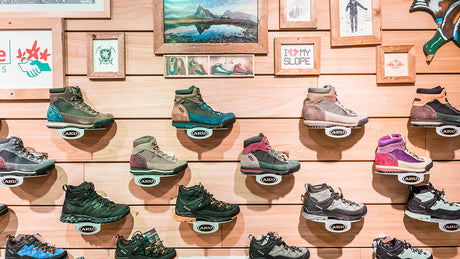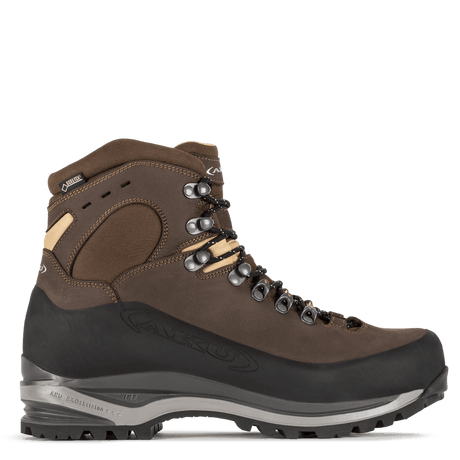
Mountain boots, after our friends and adventure companions, are our best allies. Footwear and equipment must be chosen carefully, without exceeding in weight and volume but also without sacrificing too much the comfort of walking and protection from adverse weather conditions. For each activity there is the right footwear.
OUTDOOR MEN'S COLLECTION
OUTDOOR WOMEN'S COLLECTION
Our Icons
View allHinter dem Etikett
AKU's responsible commitment is transparency towards its customers regarding the origin of the materials.
Go to the project to learn about AKU's main suppliers.
For each product, by clicking on the “ Traceability ” button it is possible to know the origin of each individual component.
QUESTIONS AND ANSWERS
How to choose mountain boots?
How to choose mountain boots?
Choosing boots has always been one of the initiation rites of the mountain, it almost seems as if our excursions started right there, in the shop, if we think about the care and expectations with which we first try the various models, to then evaluate them in detail.
detail the fit and, finally, we try to get the right size always with a little anxiety thinking about how they will behave on the first trip. The fact is that ultimately the boot, like the ice axe, is a symbol of the mountain itself, one of the few pieces that should never be missing in the wardrobe of an adventure lover.
When choosing your mountain boots remember to:
1. Think about what type of hike you will be taking
On the aku.com website you can find a wide range of models divided according to the different activities
2. Material
Nylon and Mesh : Lightweight and breathable, ideal for warm climates.
Leather : Sturdy and waterproof, but heavier. They offer good durability.
Waterproof membranes : Like Gore-Tex, to keep your feet dry.
3. Size and Fit
Try on your boots with the socks you will be hiking in.
Make sure there is enough room for your toes, but that the heel is secure.
4. Sole
Look for soles with good grip, such as Vibram rubber ones.
The depth of the lugs affects traction: deeper for softer terrain
accidents.
5. Support and Stability
Choose boots with good ankle support, especially for uneven terrain.
Sole stiffness is important for mountaineering and hiking on technical terrain.
6. Weight
If you’re planning on long hikes, lightweight boots can reduce fatigue.
7. Waterproof and breathable
Consider boots with waterproof membranes to keep water out, but that are also breathable to prevent sweat buildup.
8. Flexibility
The flexibility of the sole depends on the use: stiffer for mountaineering, softer for trekking.
9. Reviews and Recommendations
Read online reviews and ask for advice from those who already have experience with specific models.
Take the time to find the right boots: comfort and safety are essential to fully enjoy your
mountain adventures!
What is the right size?
What is the right size?
Place your feet on a sheet of paper and draw two horizontal lines corresponding to the heel and the longest toe of your feet, then measure the distance between the two lines.
By clicking on this link you can find the size chart where you can find the size corresponding to the length in cm
of your foot. For example, a foot that is 27 centimetres long corresponds to size 42 EU.
It is important to leave about half a centimeter of space in front of the toes to avoid impacts when descending and increase comfort.
Wear technical trekking socks during the test.
If you need a shoe that can be used for simple climbing in addition to traditional hiking, consider shoes that feature Dual Fit System double lacing technology. When greater precision is needed for progress on rock, simply tie the second lace that reduces the volume at the tip. Discover the Rock II model.
Are there different hiking shoes for men and women?
Are there different hiking shoes for men and women?
AKU offers footwear designed for both men and women, with an approach oriented first and foremost to the activity to be performed, rather than the gender of the wearer. The shape of the shoe is designed to guarantee maximum adaptability to the morphology of the female and male foot, ensuring comfort, stability and optimal performance.
How to properly lace up mountain boots?
How to properly lace up mountain boots?
The shoe must be adjusted evenly, avoiding pressure points and ensuring the correct locking of the foot and ankle.
When going downhill, tighten the upper part more to limit slippage at the tip.
When climbing, focus your grip on the forefoot for improved control on technical sections.
Always adjust your laces according to the type of terrain and intensity of the activity.
How to maintain mountain boots?
How to maintain mountain boots?
Regular maintenance extends the life of your footwear. On our dedicated page you can find a series of videos that show you how to clean, care for and maintain your pair of boots.






























